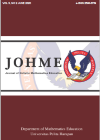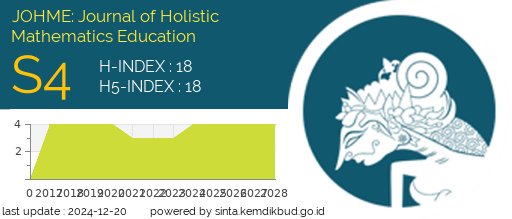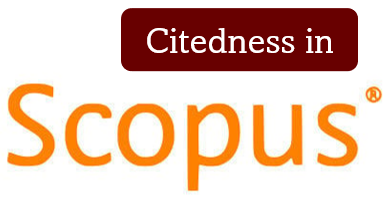THE IMPLEMENTATION OF RECEPTION-ORIENTED CAM WITH WORKSHEETS TO IMPROVE GRADE 10 STUDENTS’ CONCEPTUAL UNDERSTANDING OF QUADRATIC EQUATIONS AND FUNCTIONS IN A CHRISTIAN SCHOOL
DOI:
https://doi.org/10.19166/johme.v3i2.1578Keywords:
Classroom Action Research, concept attainment, reception-oriented CAM, worksheets, conceptual understanding, PTK, konsep matematika, lembar kerja, pemahaman konsepAbstract
Based on observations and summative test results, the researcher identified that students' difficulties in learning quadratic equations and functions was conceptual understanding. Conceptual understanding enables students to analyze, integrate, and apply a concept in different situations. The purpose of the research was to see if the implementation of the Reception-Oriented CAM with worksheets improved students’ conceptual understanding and to find an effective way to implement the method. The researcher used a two-cycle Classroom Action Research of Pelton’s with seven grade 10 female students at a Christian school in Tangerang as the research subjects. Data was collected by test sheets, observation sheets, feedback sheets, and documentation. The result showed that the Reception-Oriented CAM with worksheets could improve students’ conceptual understanding in learning quadratic equations and functions. Another result showed that an effective way to implement Reception-Oriented CAM with worksheets was through implementing all the phases of the method thoroughly by giving more time in phase three and giving detailed instruction to the students.
BAHASA INDONESIA ABSTRACT: Berdasarkan pengamatan dan hasil tes sumatif, peneliti mengidentifikasi bahwa kesulitan siswa dalam belajar persamaan dan fungsi kuadrat adalah dalam memahami konsep. Pemahaman konsep memungkinkan siswa untuk menganalisis, mengitegrasi, dan menerapkan konsep dalam berbagai situasi. Tujuan penelitian ini adalah untuk melihat manfaat penggunaan Reception Oriented CAM dengan lembar kerja untuk meningkatkan pemahaman konsep dan menemukan suatu cara yang efektif dalam penerapan metode tersebut. Penelitian tuindakan kelas dua siklus dengan model Pelton ini mengambil subyek tujuh siswi kelas 10 di suatu Sekolah Kristen di Tangerang. Data dikumpulkan dengan lembar tes, observasi, lembar umpan balik, dan dokumentasi. Hasil penelitian menunjukkan bahwa metode Reception Oriented CAM dengan lembar kerja dapat meningkatgkan pemahaman konsep siswa dalam pembelajaran persamaan dan fungsi kuadrat. Hasil penelitian juga menunjukkan bahwa cara yang efektif untuk menerapkan Reception Oriented CAM dengan lembar kerja adalah dengan cara memberikan waktu yang cukup pada langkah ke tiga dan memberikan instruksi dengan detail kepada siswa-siswa sebelum pembelajaran dimulai.
References
Anditya, N. H., Panggabean, M. S., & Dirgantoro, K. P. S. (2017). The role of Christian teachers in providing for the needs of high-achieving students. JOHME: Journal of Holistic Mathematics Education, 1(1), 10-21. https://doi.org/10.19166/johme.v1i1.710
Anjum, S. K. (2015). A study of effect of concept attainment model on achievement on geometry concept of VIII standard rural and urban students. Scholarly Research Journal for Humanity Science & English Language, 2(10), 2499-2507. Retrieved from https://issuu.com/dr.yashpalnetragaonkar/docs/10shaikh_kashefa_anjum
Arikunto, S., Suhardjono, & Supardi. (2012). Penelitian tindakan kelas. Jakarta, Indonesia: PT Bumi Aksara.
Burden, P. R., & Byrd, D. M. (2010). Methods for effective teaching: Meeting the needs of all students. Boston, MA: Allyn & Bacon.
Eggen, P., & Kauchack, D. (2012). Strategi dan model pembelajaran: Mengajarkan konten dan keterampilan berpikir. Jakarta, Indonesia: PT Indeks.
Ghazali, N. H. C., & Zakaria, E. (2011). Students' procedural and conceptual understanding of mathematics. Australian Journal of Basic and Applied Sciences, 5(7), 684-691. Retrieved from http://www.ajbasweb.com/old/ajbas/2011/July-2011/684-691.pdf
Graham, D. L. (2009). Teaching redemptively: Bringing grace and truth into your classroom. Colorado Spring, CO: Purposeful Design Publications.
Grudem, W. (1994). Systematic theology: An introduction to biblical doctrine. Grand Rapids, MI: Zondervan Publishing House.
Huda, M. (2014). Model-model pengajaran dan pembelajaran. Yogyakarta, Indonesia: Pustaka Pelajar.
Ä°nan, C., & Serdar, E. (2017). The effect of mathematical worksheets based on multiple intelligences theory on the academic achievement of the students in the 4th grade primary school. Universal Journal of Educational Research, 5(8), 1372-1377. https://doi.org/10.13189/ujer.2017.050810
Isnaini, R. (2017). Penerapan model pembelajaran pencapaian konsep dengan pendekatan RME (Realistic Mathematics Education) untuk meningkatkan kemampuan pemahaman matematis siswa pada materi bangun datar "segi empat". Simki-Techsain, 1(5), 2-7. Retrieved from http://simki.unpkediri.ac.id/mahasiswa/file_artikel/2017/0fc4eda8f010f248dbc48ddb0a8bda8b.pdf
Joyce, B., Weil, M., & Calhoun, E. (2009). Models of teaching. Boston, MA: Pearson.
Kaur, R. (2018). To study the effectiveness of concept attainment model of teaching on achievement of secondary school students in chemistry. Scholarly Research Journal for Humanity Science & English Language, 5(25), 6858-6863. https://doi.org/10.21922/srjhsel.v5i25.10942
Khirwadakar, A. (2007). Teaching chemistry: Modern method. New Delhi, India: Prabhat Kumar Sharma for Sarup & Sons.
Kilpatrick, J., Swafford, J., & Findell, B. (2001). Adding + it up: Helping children learn mathematics. Washington, DC: National Academies Press.
Kiswandi, Soedjoko, E., & Hendikawati, P. (2013). Komparasi model pembelajaran concept attainment and cognitive growth terhadap kemampuan pemahaman konsep. Unnes Journal of Mathematics Education, 2(3), 16-20. https://doi.org/10.15294/ujme.v2i3.3361
Krathwohl, D. R. (2002). A revision of Bloom's taxonomy: An overview. Theory Into Practice, 41(4), 212-218. https://doi.org/10.1207/s15430421tip4104_2
Kumar, A., & Mathur, M. (2013). Effect of concept attainment model on acquisition of physics concepts. Universal Journal of Educational Research, 1(3), 165-169. Retrieved from http://www.hrpub.org/download/201310/ujer.2013.010304.pdf
Latterell, C. M., & Wilson, J. L. (2013). What is mathematics and why does it matter? ETC: A Review of General Semantics, 70(4), 387-394. Retrieved from https://www.jstor.org/stable/24761807?seq=1
Lestari, K. E., & Yudhanegara, M. R. (2015). Penelitian pendidikan matematika. Bandung, Indonesia: PT Refika Aditama.
Ostad, G., & Soleymanpour, J. (2014). The impact of concept attainment teaching model and mastery teaching method on female high school students' academic achievement and metacognitive skill. International Journal of Innovative Research in Science, 3(2), 9774-9781. Retrieved from https://www.semanticscholar.org/paper/The-Impact-of-Concept-Attainment-TeachingModel-and-Ostad-Soleymanpour/9d5557030911c0d3c3d83bbf49be9af11c2eb1f0
Pelton, R. P. (2010). Action research for teacher candidates: Using classroom data to enhance instruction. Lanham, MD: Rowman & Littlefield Education.
Prabhakaram, & Bhaskara, D. (2006). Concept attainment model in mathematics teaching. New Delhi, India: Discovery Publishing House.
Reys, R. E. (2007). Helping children learn mathematics. Hoboken, NJ: John Wiley & Sons.
Sanjaya, W. (2009). Penelitian tindakan kelas. Jakarta, Indonesia: Kencana Paramedia Group.
Saragih, M. J., Hidayat, D., & Tamba, K. P. (2019). Implikasi pendidikan yang berpusat pada Kristus dalam kelas matematika [The implications of Christ-center education for mathematics classes]. JOHME: Journal of Holistic Mathematics Education, 2(2), 97-107. https://doi.org/10.19166/johme.v2i2.1695
Stonehouse, C. (2003). Joining children on the spiritual journey: Nurturing a life of faith. Grand Rapids, MI: Baker Books.
Suleiman, A. M. (2016). Concept attainment teaching methodology (CATM) - An effective approach for training workers on chemicals health hazards. Universal Journal of Educational Research, 4(11), 2677-2685. https://doi.org/10.13189/ujer.2016.041122
Widyoko, E. P. (2014). Penilaian hasil belajar di sekolah. Yogyakarta, Indonesia: Pustaka Belajar.Downloads
Published
How to Cite
Issue
Section
License
Authors who publish with this journal agree to the following terms:
1) Authors retain copyright and grant the journal right of first publication with the work simultaneously licensed under a Creative Commons Attribution License (CC-BY-SA 4.0) that allows others to share the work with an acknowledgement of the work's authorship and initial publication in this journal.
2) Authors are able to enter into separate, additional contractual arrangements for the non-exclusive distribution of the journal's published version of the work (e.g., post it to an institutional repository or publish it in a book), with an acknowledgement of its initial publication in this journal.
3) Authors are permitted and encouraged to post their work online (e.g., in institutional repositories or on their website). The final published PDF should be used and bibliographic details that credit the publication in this journal should be included.”










